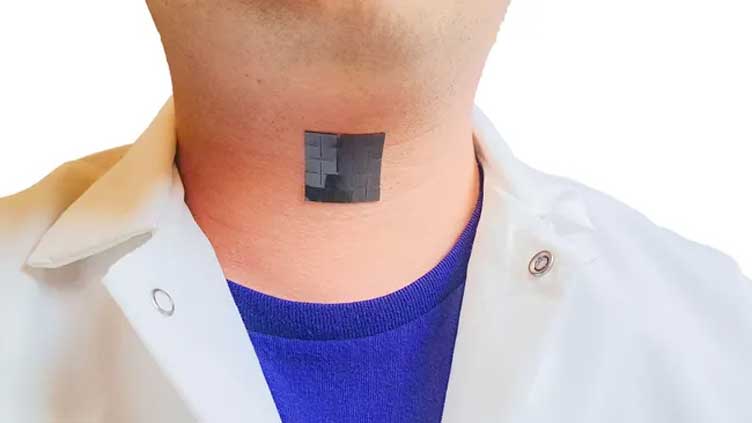Innovative throat patch could help people speak without vocal cords

WeirdNews
Self-powered throat patch uses machine learning to translate muscle movements into a speech
California (Web Desk) - Researchers at the University of California recently created a self-powered throat patch that uses machine learning to translate muscle movements into speech, helping people to speak without vocal cords.
Jun Chen, an assistant professor of bioengineering at the University of California, Los Angeles, came up with the idea for a non-invasive speech-enabling device after feeling his vocal cords get tired as a result of lecturing for several hours at a time.
He began thinking of ways of helping a person speak without using their vocal cords, and with the help of his colleagues at the University of California, he designed an innovative patch that sticks to the user’s throat and uses AI technology to decode their muscle movements into speech.
The lightweight device is resistant to skin sweat and also harnesses the user’s muscle movements to generate electricity, which means that it doesn’t require a battery to operate.
In a study published in the Nature Scientific Journal, Prof. Jun Chen and his team explain how their 7.2-gram, self-powering throat patch works. The tiny device is made up of five thin layers, including materials that respond to the subtle movements of throat muscles.
When the wearer executes the movements necessary to pronounce a phrase, the materials respond by producing electrical signals that can then be translated into speech with the help of machine learning technology.
The outer layers of the patch are made of soft, flexible silicone material, while the central layer is made of silicon and micromagnets and generates a magnetic field that varies depending on the movements of the muscles.
The other two middle layers are made of coils of copper wire that transform the magnetic field changes into electrical impulses.
In an experiment detailed in their study, Chen and his colleagues fed electrical impulses to a machine-learning algorithm that ended up transforming them into spoken phrases.
To train the algorithm, the eight participants in the study had to utter five short phrases 100 times each while wearing the patch, so that the algorithm could learn to associate each phrase with its specific muscle movements.
The study showed that the algorithm was about 95% accurate at translating the patch’s electrical impulses into speech, both when the phrases were spoken out loud and when pronounced “voicelessly”.
This suggests that the algorithm can reliably interpret waveforms and translate them into speech, but Prof. Chen also points out that his study has limitations.
Testing was limited to just the eight people saying five phrases, and none of them were suffering from speech disorders. Plus, even if the patch were to prove effective in a larger study, the logistics of producing it on a large scale still have to be figured out.


